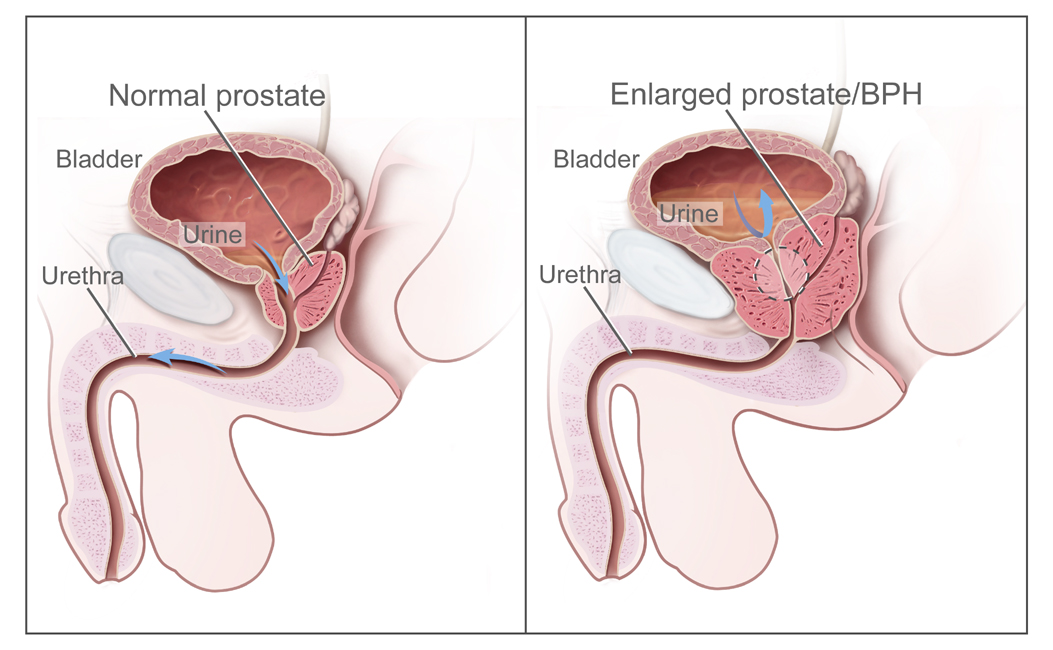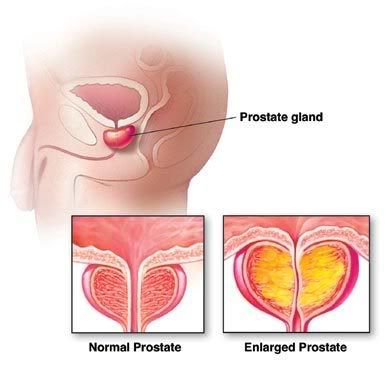
What is the prostate gland?
The prostate is a small organ about the size of a walnut. It lies below the bladder (where urine is stored) and surrounds the urethra (the tube that carries urine from the bladder). The prostate makes a fluid that helps to nourish sperm as part of the semen (ejaculatory fluid).
Prostate problems are common in men 50 and older. Most can be treated successfully without harming sexual function. A urologist is a specialist in diseases of the urinary system, including diagnosing and treating problems of the prostate gland.
How does the doctor detect prostate enlargement?
A doctor usually can detect an enlarged prostate by rectal exam. The doctor also may examine the urethra, prostate, and bladder using a cytoscope, an instrument that is inserted through the penis.
What is benign prostatic hyperplasia?
Benign prostatic hyperplasia is nonmalignant (noncancerous) enlargement of the prostate gland, a common occurrence in older men. It is also known as benign prostatic hyperplasia and abbreviated as BPH.
When does benign prostatic hyperplasia start?
BPH generally begins in a man's 30s, evolves slowly, and most commonly only causes symptoms after 50.
What happens in BPH? What are symptoms of BPH?
In BPH, the prostate gland grows in size. It may compress the urethra which courses through the center of the prostate. This can impede the flow of urine from the bladder through the urethra to the outside. It can cause urine to back up in the bladder (retention) leading to the need to urinate frequently during the day and night. Other common symptoms include a slow flow of urine, the need to urinate urgently and difficulty starting the urinary stream. More serious problems include urinary tract infections and complete blockage of the urethra, which may be a medical emergency and can lead injury to the kidneys.

How common is BPH? Are there any risk factors?
BPH is extremely common. Half of all men over 50 develop symptoms of BPH, but only 10% need medical or surgical intervention.
Is BPH a type of cancer?
No! BPH is completely benign. It is not a precursor (a forerunner) to prostate cancer.
Is BPH always treated?
No. Treatment of BPH is usually reserved for men with significant symptoms. Watchful waiting with medical monitoring once a year is appropriate for most men with BPH.
How is BPH treated?
There are several different ways to treat BPH:
- Watchful waiting is often chosen by men who are not bothered by symptoms of BPH. They have no treatment but get regular checkups and wait to see whether or not the condition gets worse.
- Medical treatment of BPH is usually reserved for men who have significant symptoms. The available drugs include
- alpha blockers relax the smooth muscles of the prostate, and the bladder neck, which helps to relieve urinary obstruction caused by an enlarged prostate in BPH. Side effects can include headaches, fatigue, or lightheadedness. Commonly used alpha blockers in BPH include tamsulosin (Flomax), alfuzosin (Uroxatral), and older medications such as terazosin (Hytrin) or doxazosin (Cardura). These drugs generally will lead to improvement in symptoms within several weeks and have no effect on prostate size; and
- 5-alpha reductase inhibitors block the conversion of the male hormone testosterone into its active form in the prostate (DHT). The prostate enlargement in BPH is directly dependent on DHT, so these drugs lead to an approximate 25% reduction in prostate size over six to 12 months. For this reason, improvement in urinary symptoms most commonly takes this long to occur. Examples of 5-alpha reductase inhibitors include Finasteride (Proscar) and dutasteride (Avodart). Side effects of finasteride may include declining interest in sex, problems getting an erection, and problems with ejaculation.
- Surgery or office procedures may also be used to treat BPH, most commonly in men who have not responded satisfactorily to medication or those who have more severe problems, such as a complete inability to urinate.
- Transurethral resection of the prostate (TURP) has been used for the longest period of time. After the patient is given anesthesia, the doctor inserts a special instrument into the urethra through the penis. With the instrument, the doctor then shaves away part of the inner prostate to relieve the outflow of urine from the bladder.
- Laser procedures: A number of laser procedures are available, some of which can be performed in the doctor's office with minimal anesthesia. These procedures also involve the removal of obstructing prostate tissue. They are generally associated with less bleeding and quicker recovery than TURP but may not be as effective over the long term in some men.
- Microwave therapy: This procedure is generally performed in the office and involves the use of microwave energy delivered to the prostate to kill some of the cells leading eventually to shrinkage of the prostate.
Men should carefully weigh the risks and benefits of each of these options. Prostate surgery has traditionally been seen as offering the most benefits for BPH but unfortunately carries the most risks.

Are there other noncancerous prostate problems?
Yes, aside from BPH, there are a number of prostate problems that also have nothing at all to do with cancer. Among these benign disorders of the prostate are acute prostatitis and chronic prostatitis.
Acute prostatitis is a bacterial infection of the prostate. It can occur in men at any age. Symptoms include fever, chills, and pain in the lower back and between the legs. This problem also can make it hard or painful to urinate. Doctors prescribe antibiotics for acute prostatitis and recommend that the patient drink more liquids. Treatment is usually successful.
Chronic prostatitis is a prostate inflammation that tends to recur over time. It is usually not associated with true bacterial infection but causes similar symptoms of pain and discomfort, without fevers or chills. Chronic prostatitis is difficult to treat, and the exact cause is not well understood. Antibiotics may be used in some cases as well as antiinflammatory medications such as ibuprofen. In many cases, symptoms will resolve on their own.
Can prostate problems be prevented?
The best protection against prostate problems is to have regular medical checkups that include a careful prostate exam. See a doctor promptly if symptoms occur such as
- a frequent urge to urinate,
- difficulty in urinating, or
- dribbling of urine.
Regular checkups are important even for men who have had surgery for BPH. BPH surgery does not protect against prostate cancer because only part of the prostate is removed. In all cases, the sooner a doctor finds a problem, the better the chances that treatment will work.
Benign Prostatic Hyperplasia At A Glance
- The prostate gland makes a fluid that becomes part of the semen.
- Benign prostatic hyperplasia (BPH) involves enlargement of the prostate gland.
- The prostate enlargement in BPH is not malignant.
- BPH can impede the flow of urine.
- Symptoms include frequent urge to urinate, difficulty urinating and dribbling of urine.
- The treatment of BPH is usually reserved for men with significant symptoms.
- Medical and surgical approaches are available to treat BPH.
sourceLast Editorial Review: 6/23/2008
|
Bookmark this post:
|
|

0 comments
Post a Comment